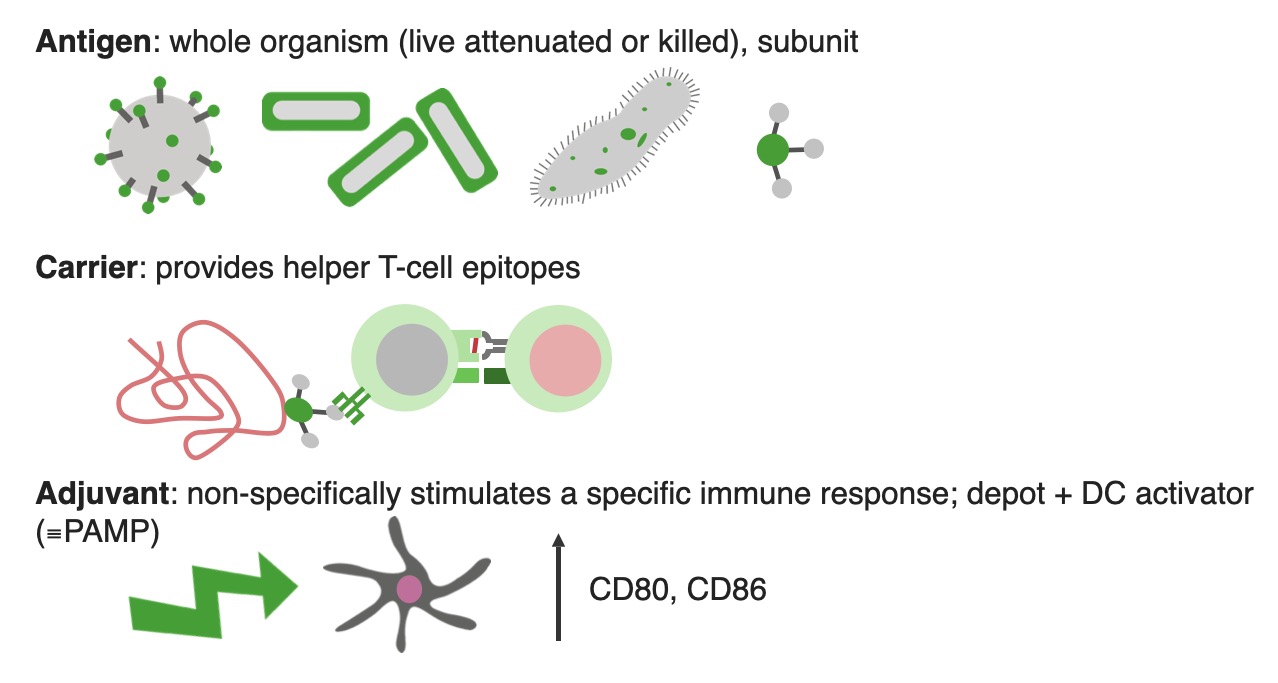Playlist
Show Playlist
Hide Playlist
Types of Vaccines (1): Live Attenuated Vaccines and Inactivated Vaccines
-
Slides Vaccine Immunology.pdf
-
Reference List Immune System.pdf
-
Download Lecture Overview
00:01 Anything has an advantage and a disadvantage, and vaccines are no exception to that. 00:06 So what are the advantages and disadvantages of live attenuated vaccines? Well the advantages are that they mimic the natural infection, and thus provide an appropriate immune response. 00:19 They stimulate the right type of immune response for protection against that particular pathogen. 00:24 They can stimulate both humoral, in other words the antibody mediated, and the cell mediated responses involving cytotoxic T-lymphocytes. 00:34 And they typically generate long term immunity with a reduced need for booster immunizations. 00:41 I mean the Holy Grail if you like, of vaccination is one shot lifelong protection. 00:48 And the less number of boosts you give-- need to give, the better obviously. 00:55 What about the disadvantages? Well there is a slight potential to revert back to virulent forms. 01:02 They’re still alive, they’ve been altered so they are not nearly as pathogenic as the normal pathogen. 01:08 But they could undergo mutations that would make them unacceptably pathogenic. 01:15 They often require refrigeration. 01:19 They have the potential to spread from one vaccinee to another person. 01:24 So somebody being given this vaccine could then pass this live organism on to somebody else. 01:32 And they are contraindicated in the immunocompromised due to the risk of significant pathology. 01:40 In immunologically intact individuals, these live organisms are dealt with perfectly adequately, they don’t cause significant pathology. 01:49 But it an individual with a compromised immune system, for example somebody with an immunodeficiency, or somebody being treated with immunosuppressive drugs, perhaps because they have received a transplant. 02:02 Then these organisms can actually cause significant pathology. 02:08 An important aspect of live attenuated vaccines-- is that they replicate at the site of infection. 02:15 So here we can see a live vaccine that is replicating at the mucosal surface. 02:22 And this provides a really appropriate type of immunity. 02:27 So a strong IgA response, exactly where the protection is needed, at the point that the pathogenic organism would be first encountered. 02:40 Examples of live attenuated vaccines include the intranasal form of the influenza vaccine, the MMR (Measles-Mumps-Rubella) vaccine, the oral polio vaccine, rotavirus, varicella zoster virus that protects against chickenpox and shingles and the yellow fever vaccine. 03:04 These are all vaccines against viruses. 03:07 There are also examples of live attenuated vaccines against bacterial diseases - the oral live typhoid vaccine and the BCG vaccine. 03:23 What about inactivated vaccines? What are the advantages and disadvantages of those? Well they are relatively easy to manufacture. 03:33 There’s no possibility of reversion to virulent pathogens because they’re inactivated, they’re dead. 03:39 And therefore they’re also safe to use in the immunocompromised. 03:46 The disadvantages are that adjuvants are usually required. 03:52 Typically they require an initial two to three immunizations and then relatively frequent boosts. 04:00 And the immunity can be fairly short-lived with predominantly humoral, in other words antibody mediated responses, and rather poor cell-mediated immunity. 04:12 Examples of inactivated vaccines are the Hepatitis A virus vaccine, the influenza vaccine (that’s the inactivated version rather than the intranasal version which is live that we just mentioned), Japanese encephalitis virus, the inactivated polio virus, rabies and tick borne encephalitis virus.
About the Lecture
The lecture Types of Vaccines (1): Live Attenuated Vaccines and Inactivated Vaccines by Peter Delves, PhD is from the course Vaccine Immunology. It contains the following chapters:
- A Closer Look at Live Attenuated Vaccines
- A Closer Look at Inactivated Vaccines
Included Quiz Questions
Which of the following vaccines are typically live attenuated vaccines?
- Rotavirus
- Hepatitis A virus
- Rabies virus
- Cholera vaccine
- Plague vaccine
Which of the following is NOT a disadvantage of live attenuated vaccines?
- They typically generate shorter-lasting immunity.
- They have the potential to spread from one vaccinee to another.
- They cannot be administered to immunocompromised patients.
- They often require refrigeration.
- They have the potential to revert back to the virulent form.
Which of the following vaccines is typically inactivated?
- Hepatitis A
- Rotavirus
- Yellow fever
- Rubella
- Bacillus Calmette–Guérin
Customer reviews
5,0 of 5 stars
| 5 Stars |
|
5 |
| 4 Stars |
|
0 |
| 3 Stars |
|
0 |
| 2 Stars |
|
0 |
| 1 Star |
|
0 |




